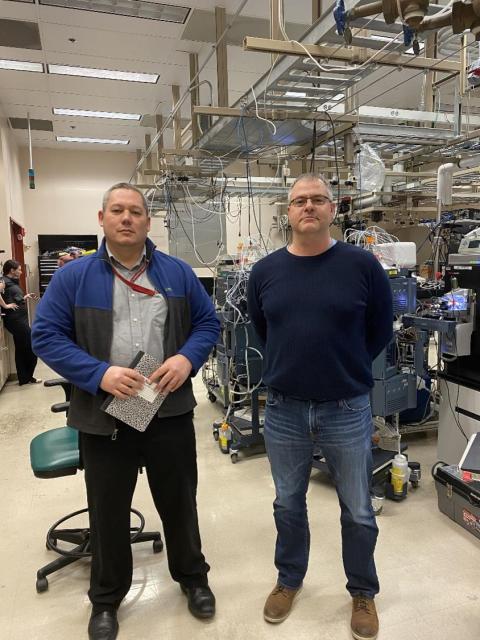Center Leverages PNNL Science and Technology for Chemical Security
National laboratory collaboration enhancing chemical detection capabilities

Scientists at Pacific Northwest National Laboratory are supporting the Department of Homeland Security Science and Technology Directorate’s Chemical Security Analysis Center in enhancing detection and analysis of chemical threats.
(Composite image by Shannon Colson | Pacific Northwest National Laboratory)
Scientists at Pacific Northwest National Laboratory (PNNL) are supporting the Department of Homeland Security (DHS) Science and Technology Directorate's (S&T) Chemical Security Analysis Center (CSAC) in improving capabilities to enhance detection and analysis of chemical threats. The work was featured in the CSAC annual report recently published online.
“We’re so excited to have our team collaborate with CSAC to better understand DHS’s chemical security challenges and where our science and technology can have an impact,” said Kate Schultz, data scientist in PNNL’s Computational Biology Group.
The work is part of an ongoing effort by PNNL to partner with the DHS S&T's Office of National Laboratories and CSAC to coordinate subject matter exchanges that build understanding of the department’s mission and where partnerships with national laboratories, like PNNL, might help.
“PNNL does world-class basic and early applied research that can meet many end-user needs within DHS. Collaboration between PNNL and the S&T Office of National Laboratories is an excellent opportunity to connect PNNL’s research to new capabilities and tools for the DHS mission. More specifically, PNNL’s research potentially gives DHS the tools to detect, identify, and interdict new chemical threats, especially synthetic opioids,” said Jerry Cabalo, a chemist at CSAC.
During exchanges, PNNL and CSAC staff members have had the opportunity connect with, observe, and learn more about capabilities, expertise, and facilities across the national security enterprise.
As an example, “By having CSAC staff visit our laboratory, we were able to share the breadth of measurement science capabilities we have at PNNL,” said PNNL Laboratory Fellow and Biological Sciences Division Chief Science Officer, Tom Metz.

The report highlights a collaboration between CSAC, PNNL, the Defense Threat Reduction Agency, the National Institutes of Health, and the U.S. Food and Drug Administration. The project explored new detection instrumentation and algorithms to enhance detection of chemical threats, like new fentanyl analogs. This collaborative effort resulted in software to automate calculation of properties in synthetic opioids. Such calculations could be used with machine learning to build mathematical models that better predict toxicological values for emerging opioids—something that poses a deadly threat to the public and first responders who respond to incidents in the field.
“A key benefit of this collaboration is exposing our staff directly to the national security mission elements at CSAC. These exchanges bring it home in a different way, letting researchers see the work that they do at other sites compared to the research at PNNL,” said Kristin Omberg, senior technical advisor. PNNL is partnering with CSAC to coordinate future staff member exchanges later this year.
Published: March 13, 2024